# A tibble: 6 × 2
x y
<dbl> <chr>
1 1 Marie
2 2 Marie
3 3 Katie
4 4 Mary
5 5 Mary
6 6 Mary Midterm + More Practice!
Lecture 10
May 29, 2025
Announcements
- I will not hold office hours on Tuesday, June 3rd: this is when you have your take home!
- Replacement midterm review office hours: June 2nd (3:30 - 5:30)
- Be in class and lab on Monday!!!!
- Tomorrow: Review game!
Midterm Exam 1
Worth 20% of your final grade; consists of two parts:
In-class: worth 70% of the Midterm 1 grade;
Take-home: worth 30% of the Midterm 1 grade.
Material
Everything we have done so far:
- plotting data with
ggplotand interpreting plots - computing and understanding summary statistics
- transforming data (row/column/grouping operations)
- pivoting & joining data
- data types/classes
- importing data
- Monday’s class: data science ethics
In-class
All multiple choice
You get both sides of one 8.5” x 11” note sheet that you and only you created (written, typed, iPad, etc)
Important
If you have testing accommodations, make sure I get proper documentation from SDAO and make appointments in the Testing Center ASAP. The appointment should overlap substantially with our class time if possible.
What should I put on my cheat sheet?
- description of common functions;
- examples of function usage;
- description of different visualizations: how to interpret, and what to use when;
- doodles;
- cute words of affirmation.
Warning
Don’t waste space on the details of any specific applications or datasets we’ve seen (penguins, Bechdel, gerrymandering, midwest, etc). Anything we want you to know about a particular application will be introduced from scratch within the exam.
Example in-class question
Which command can replace a pre-existing column in a data frame with a new and improved version of itself?
group_bysummarizepivot_widergeom_replacemutate
Example in-class question
Example in-class question
Which box plot is visualizing the same data as the histogram?


Example in-class question
What code could have been used to produce df_result? Select all that apply.
df_X
| state | year |
|---|---|
| LA | 2025 |
| NC | 2025 |
| LA | 2024 |
df_Y
| state | region |
|---|---|
| LA | south |
| NC | south |
| CA | west |
df_result
| state | year | region |
|---|---|---|
| LA | 2025 | south |
| NC | 2025 | south |
| LA | 2024 | south |
-
left_join(df_X, df_Y)
-
right_join(df_X, df_Y)
-
full_join(df_X, df_Y)
-
anti_join(df_Y, df_X)
-
right_join(df_Y, df_X)
Take-home
- It will be just like a lab, but shorter;
- Completely open-resource, but citation policies apply;
- Absolutely no collaboration of any kind;
- Seek help by posting privately on Ed;
- Submit your final PDF to Gradescope in the usual way.
Reminder: conduct policies
- Uncited use of outside resources or inappropriate collaboration will result in a zero and be referred to the conduct office;
- If a conduct violation of any kind is discovered, your final letter grade in the course will be permanently reduced (A- down to B+, B+ down to B, etc);
- If folks share solutions, all students involved will be penalized equally, the sharer the same as the recipient.
Things you can do to study
- Practice problems: released Thursday February 13;
- Attend class tomorrow: review game
- Old labs: correct parts where you lost points;
- Old AEs: complete tasks we didn’t get to and compare with key;
- Code along: watch these videos specifically;
- Textbook: odd-numbered exercises in the back of IMS Chs. 1, 4, 5, 6
Let’s Practice!
Today’s Goals:
- Goal 1: Practice data transformation and working with characters - sales data from yesterday
- Goal 2: ✨Beautify✨ the plot from AE-08: plotting + factors
- Goal 3: Practice pivoting with AE-08 data
Goal 1: Transform Sales Data
Yesterday: read an Excel file with non-tidy data

Goal 1: Transform Sales Data
Yesterday: read an Excel file with non-tidy data

Goal 1: Transform Sales Data
Goal: tidy up the data


String Functions
We’ve seen lots of functions that deal with numeric data (mean, median, sum, etc.) - what about characters?
stringr is a tidyverse package with lots of functions for dealing with character strings
today: str_detect in stringr
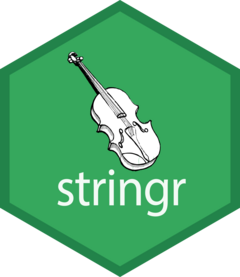
String Functions
str_detect() identifies if some characters are a substring of a larger string
-
useful in cases when you need to check some condition, for example:
in a
filter()in an
if_else()orcase_when()
String Functions
str_detect() identifies if some characters are a substring of a larger string
-
useful in cases when you need to check some condition, for example:
in a
filter()in an
if_else()orcase_when()
example: which classes in a list are in the stats department?
String Functions
General form:
Let’s get started!
Open up yesterday’s AE file (AE-09).
Let’s get started!
Create Brand Column
Create Brand Column
Create Brand Column
# A tibble: 9 × 4
id n is_brand_name brand
<chr> <chr> <lgl> <chr>
1 Brand 1 n TRUE Brand 1
2 1234 8 FALSE <NA>
3 8721 2 FALSE <NA>
4 1822 3 FALSE <NA>
5 Brand 2 n TRUE Brand 2
6 3333 1 FALSE <NA>
7 2156 3 FALSE <NA>
8 3987 6 FALSE <NA>
9 3216 5 FALSE <NA> Create Brand Column
# A tibble: 9 × 4
id n is_brand_name brand
<chr> <chr> <lgl> <chr>
1 Brand 1 n TRUE Brand 1
2 1234 8 FALSE Brand 1
3 8721 2 FALSE Brand 1
4 1822 3 FALSE Brand 1
5 Brand 2 n TRUE Brand 2
6 3333 1 FALSE Brand 2
7 2156 3 FALSE Brand 2
8 3987 6 FALSE Brand 2
9 3216 5 FALSE Brand 2Keep Needed Rows
# A tibble: 7 × 4
id n is_brand_name brand
<chr> <chr> <lgl> <chr>
1 1234 8 FALSE Brand 1
2 8721 2 FALSE Brand 1
3 1822 3 FALSE Brand 1
4 3333 1 FALSE Brand 2
5 2156 3 FALSE Brand 2
6 3987 6 FALSE Brand 2
7 3216 5 FALSE Brand 2Keep Needed Columns
# A tibble: 7 × 3
brand id n
<chr> <chr> <chr>
1 Brand 1 1234 8
2 Brand 1 8721 2
3 Brand 1 1822 3
4 Brand 2 3333 1
5 Brand 2 2156 3
6 Brand 2 3987 6
7 Brand 2 3216 5 Goal 2: Beautify AE-08 Plot
Data:
# A tibble: 12 × 4
month avg_high_f avg_low_f precip
<chr> <dbl> <dbl> <dbl>
1 January 49 28 4.45
2 February 53 29 3.7
3 March 62 37 4.69
4 April 71 46 3.43
5 May 79 56 4.61
6 June 85 65 4.02
7 July 89 70 3.94
8 August 87 68 4.37
9 September 81 60 4.37
10 October 71 47 3.7
11 November 62 37 3.39
12 December 53 30 3.43Goal 2: Beautify AE-08 Plot
Original Plot:
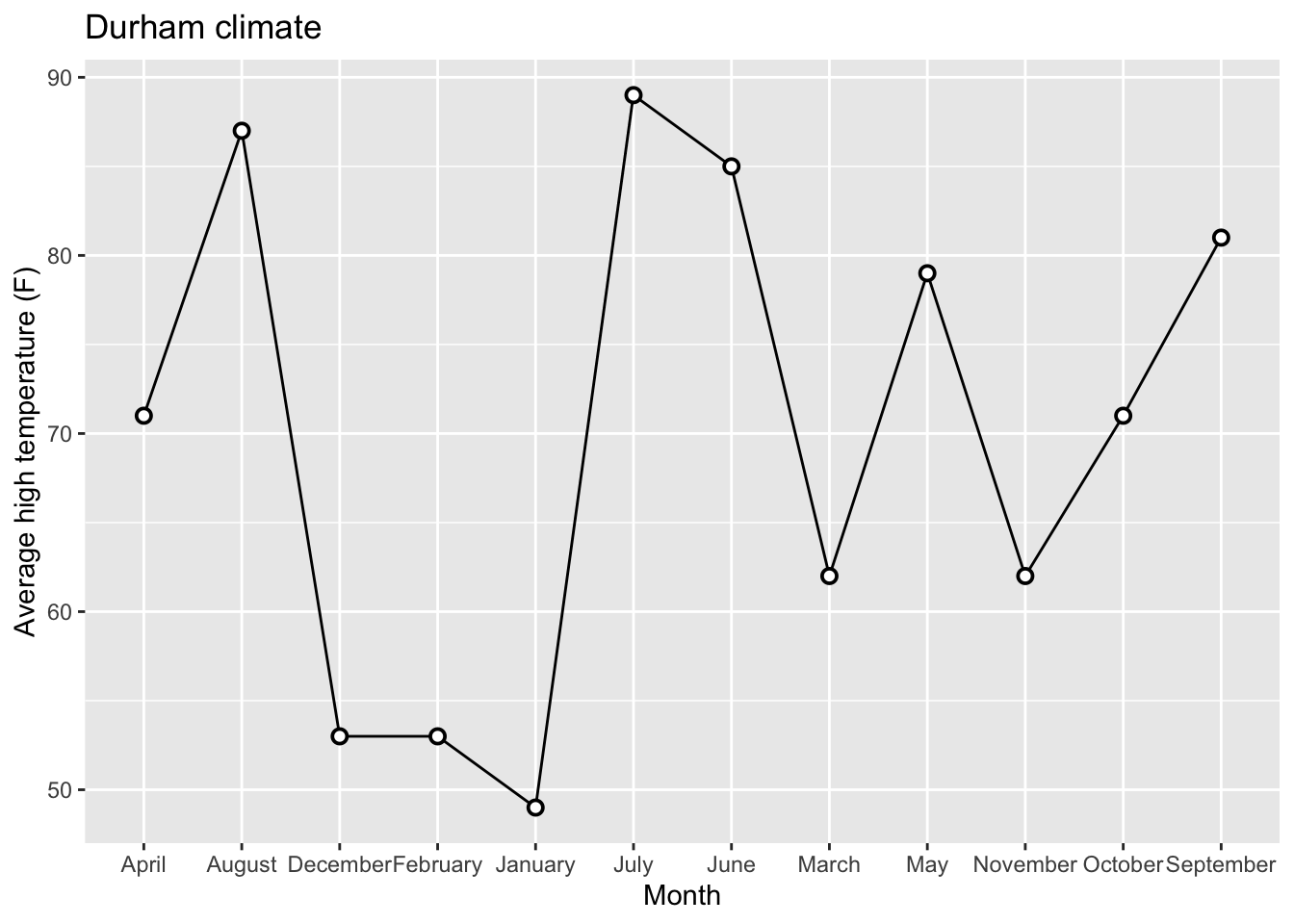
Goal 2: Beautify AE-08 Plot
Releveling Months:
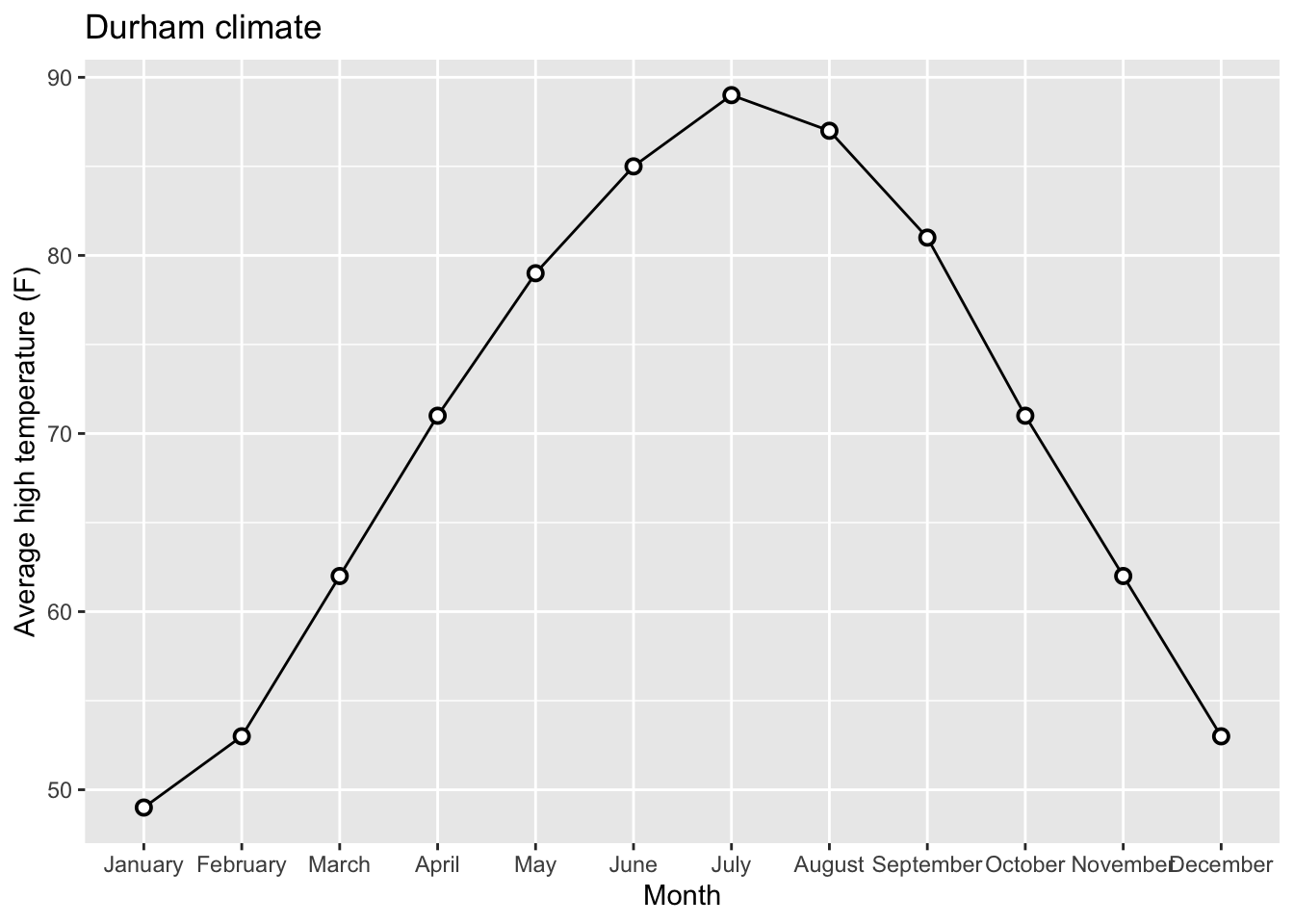
Goal 2: Beautify AE-08 Plot
Goal:
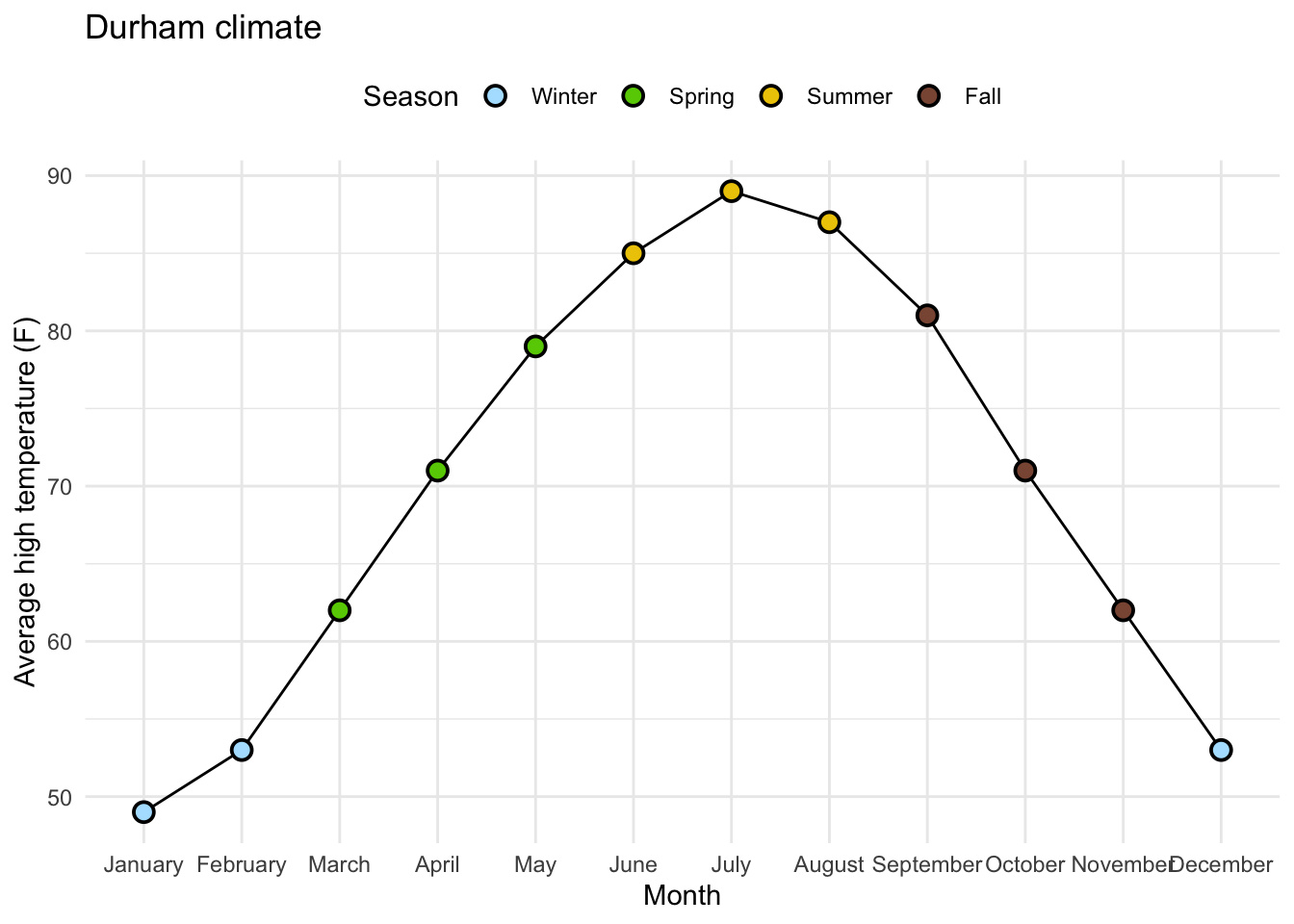
Goal: Beautify AE-08 Plot
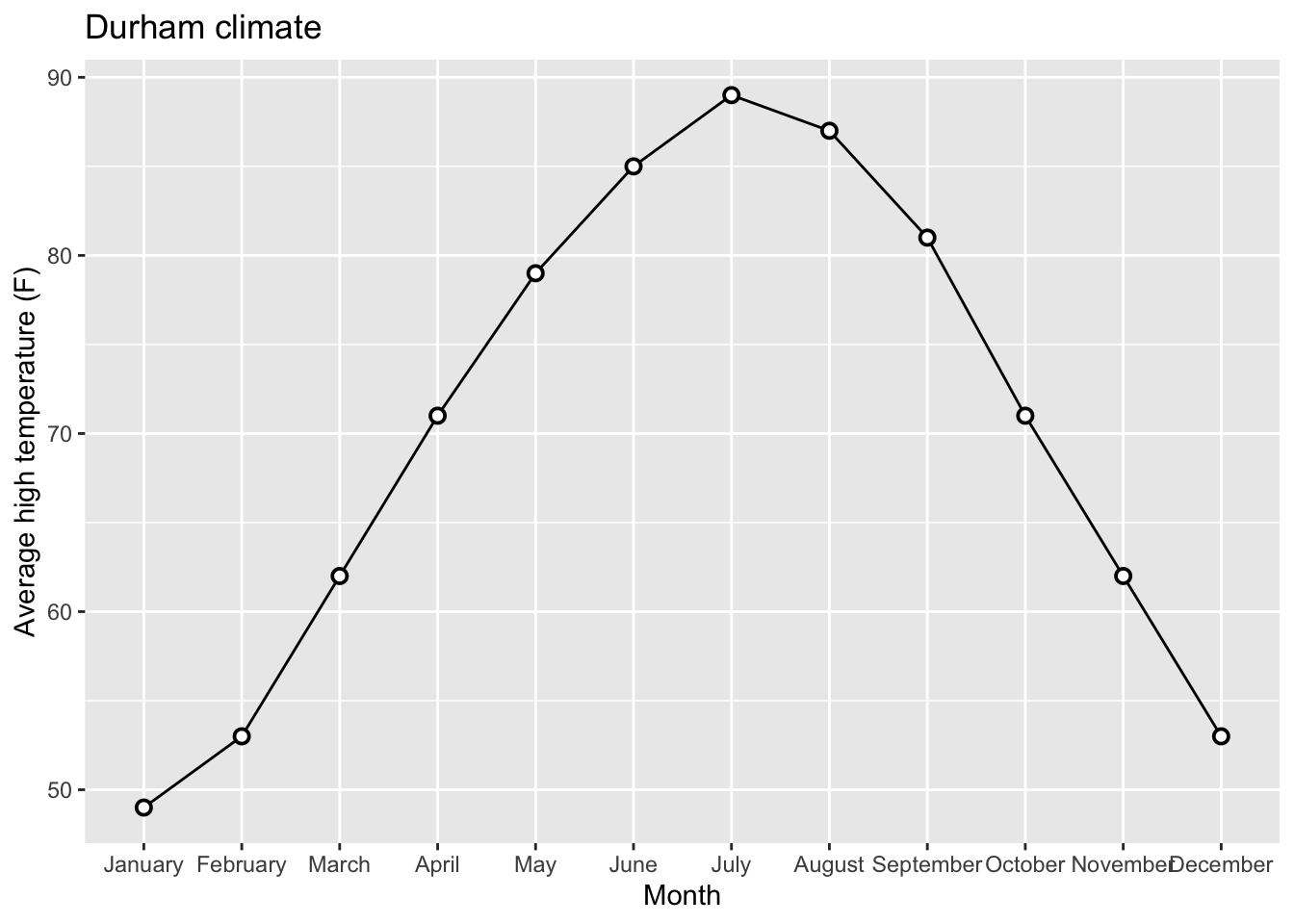
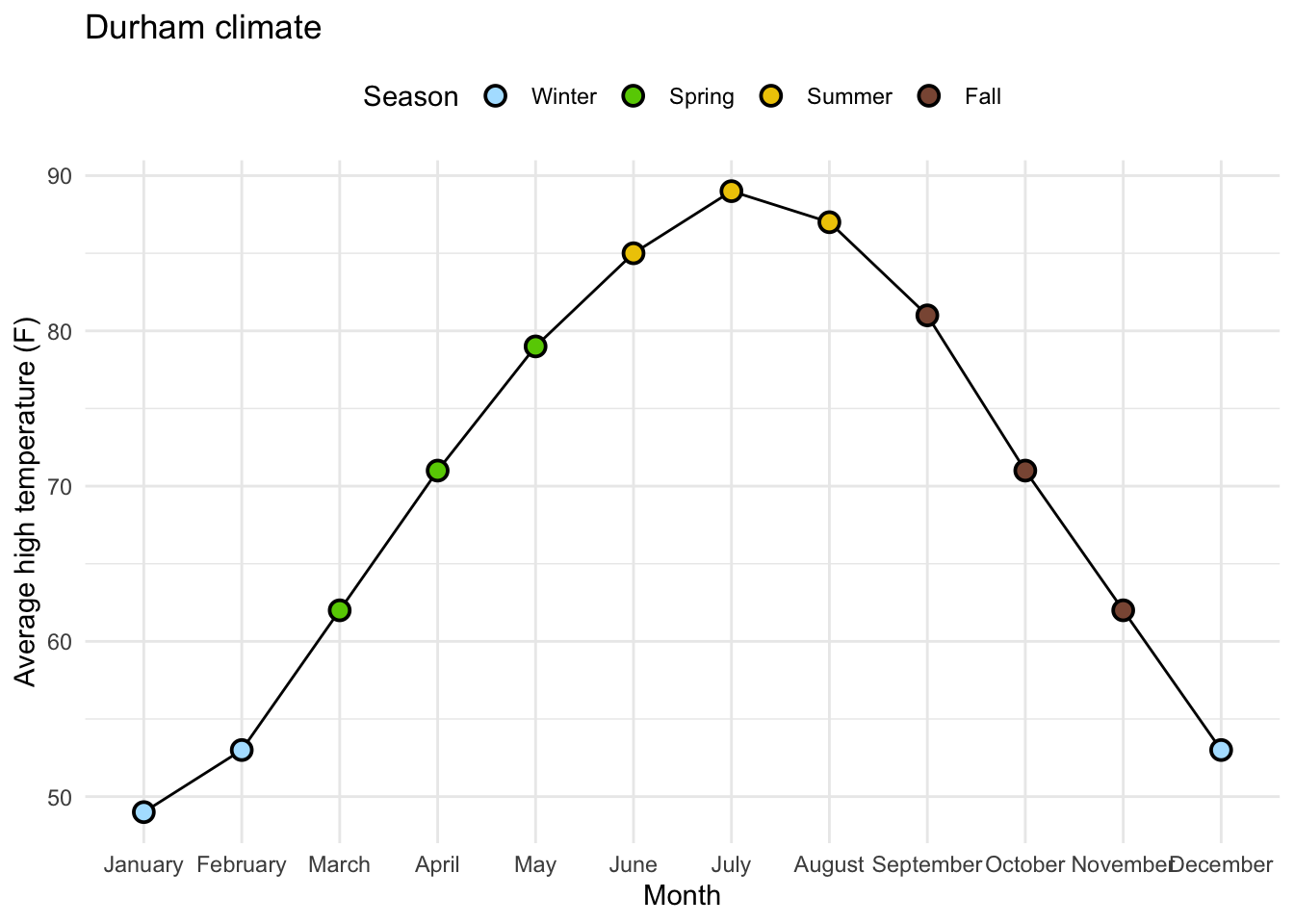
# A tibble: 12 × 4
month avg_high_f avg_low_f precip
<fct> <dbl> <dbl> <dbl>
1 January 49 28 4.45
2 February 53 29 3.7
3 March 62 37 4.69
4 April 71 46 3.43
5 May 79 56 4.61
6 June 85 65 4.02
7 July 89 70 3.94
8 August 87 68 4.37
9 September 81 60 4.37
10 October 71 47 3.7
11 November 62 37 3.39
12 December 53 30 3.43The Code…
Take a look at the printout!W hat does each highlighted portion do?
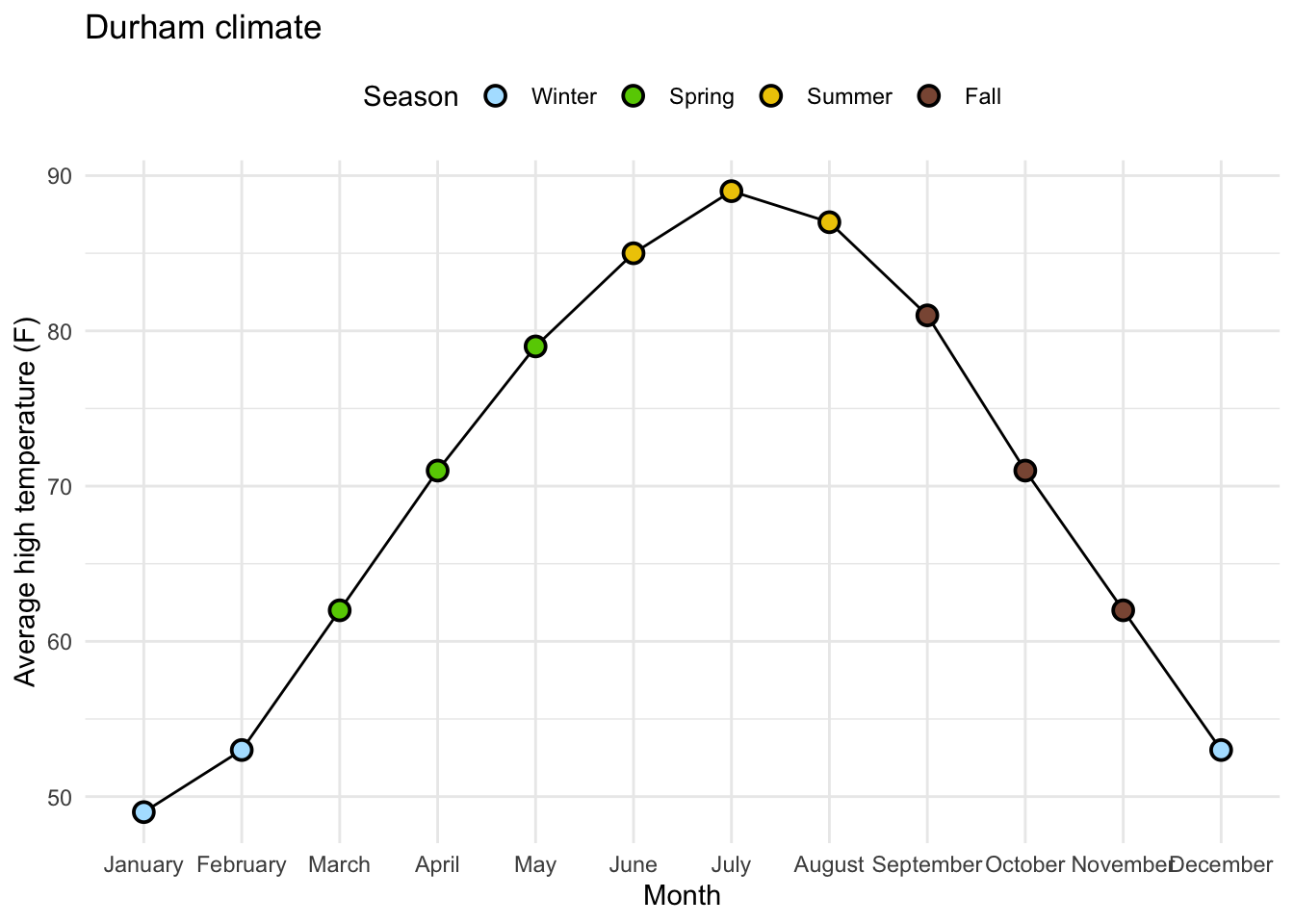
The Code…
Go ahead and pull today’s AE - mess around with the code.
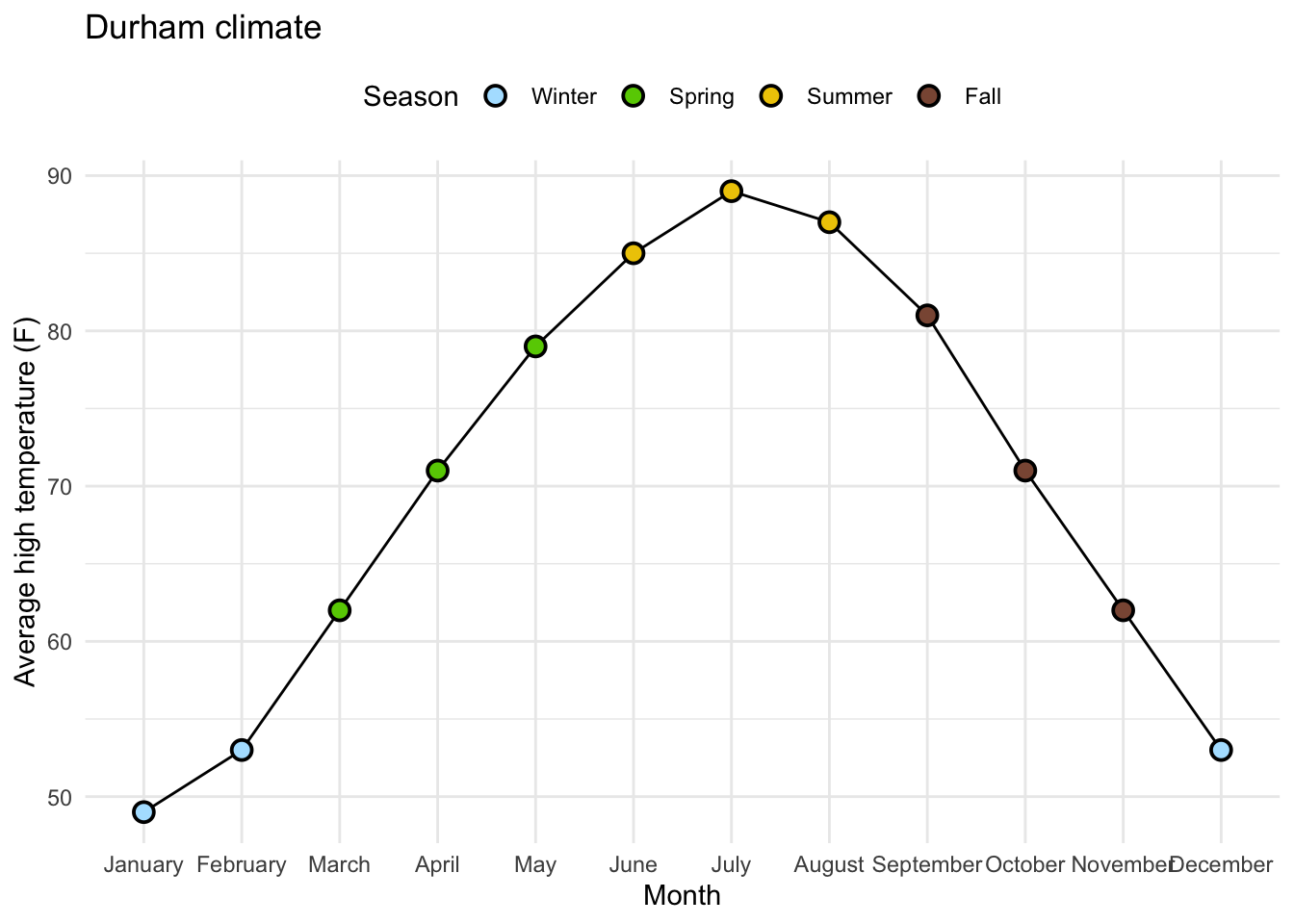
Goal 3: High/Low lines
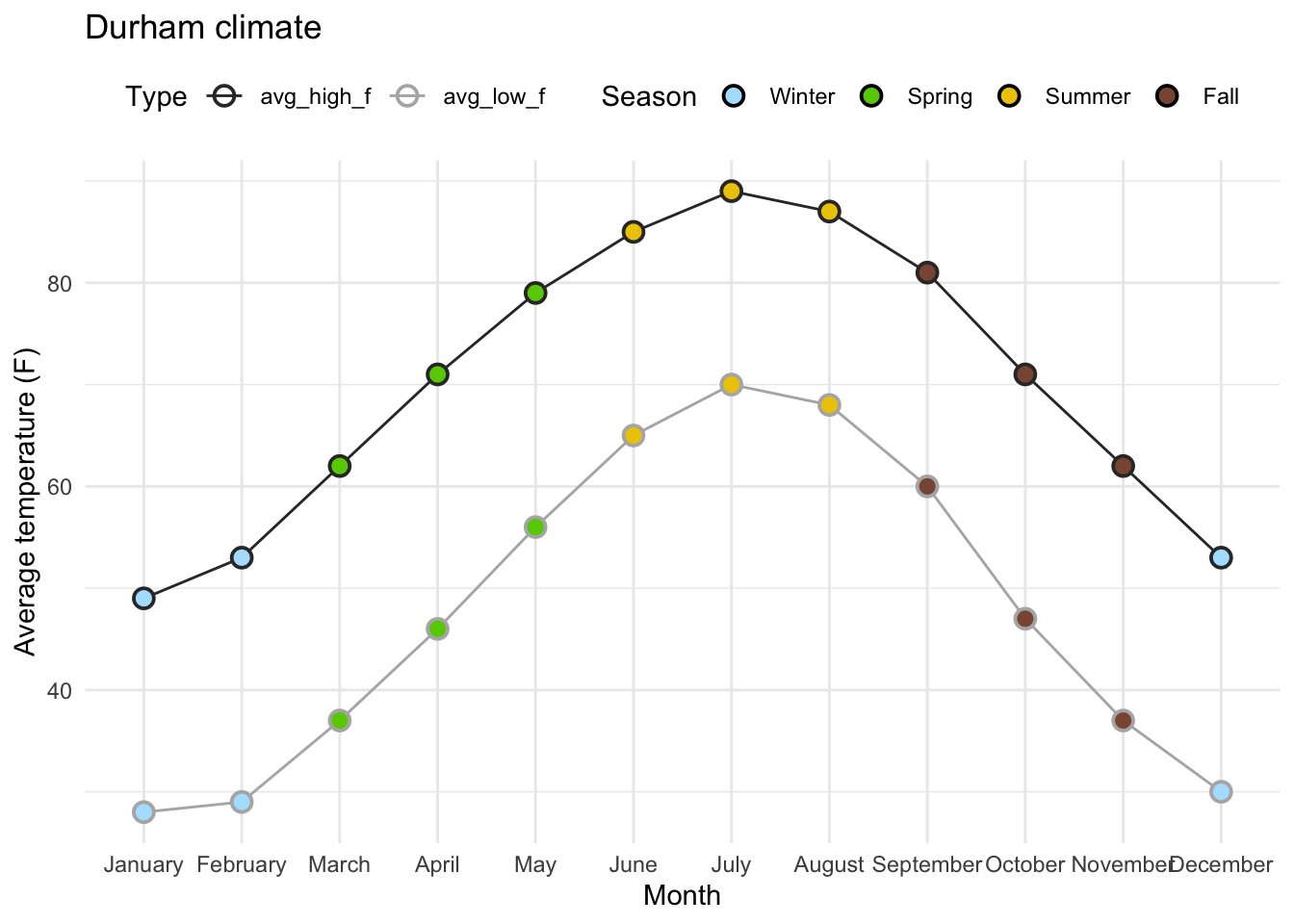
Goal 3: High/Low lines
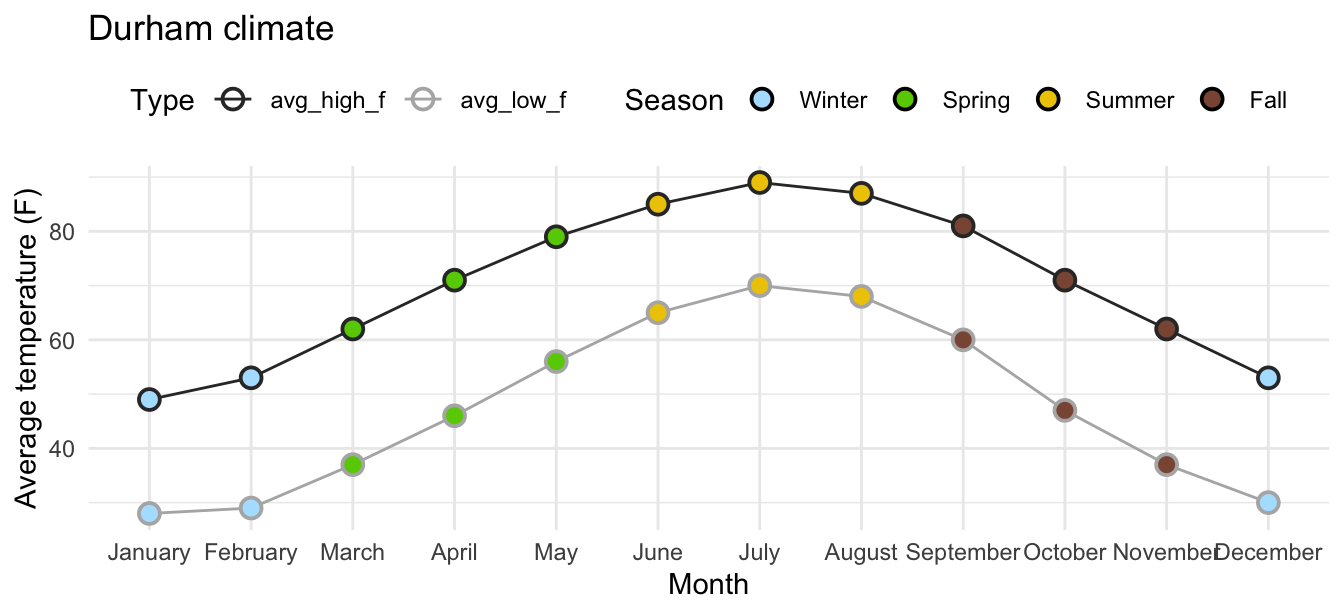
# A tibble: 3 × 5
month avg_high_f avg_low_f precip season
<fct> <dbl> <dbl> <dbl> <fct>
1 January 49 28 4.45 Winter
2 February 53 29 3.7 Winter
3 March 62 37 4.69 SpringPivot!!!
# A tibble: 5 × 5
month avg_high_f avg_low_f precip season
<fct> <dbl> <dbl> <dbl> <fct>
1 January 49 28 4.45 Winter
2 February 53 29 3.7 Winter
3 March 62 37 4.69 Spring
4 April 71 46 3.43 Spring
5 May 79 56 4.61 Spring# A tibble: 5 × 5
month precip season temp_type temp
<fct> <dbl> <fct> <chr> <dbl>
1 January 4.45 Winter avg_high_f 49
2 January 4.45 Winter avg_low_f 28
3 February 3.7 Winter avg_high_f 53
4 February 3.7 Winter avg_low_f 29
5 March 4.69 Spring avg_high_f 62Pivot!!!
Add your pivot code to today’s AE. Check out the plotting code! What is going on?
